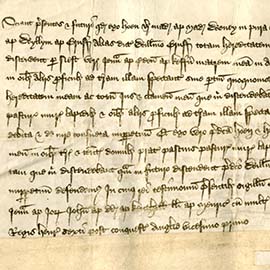Archives and Collections
The extent and diversity of the historical evidence which can support and inspire research into the history of Welsh estates is substantial, ranging from archives and records, manuscripts and printed texts to landscapes, the built environment and a range of visual, material and performative culture. Our projects tend to be underpinned by the archives and cultural heritage collections which were created, collected or preserved by landed families and estates, and their associated communities and activities.
Estate Archives
Estate archives are especially important to the development of our work. These are accumulations of records which were produced to record and facilitate the acquisition, inheritance and management of land, and often incorporate an array of other records relating to the operation of the country house and estate and the interests, activities and careers of their owners.
The chronological, geographical and subject scope of these collections can be extraordinarily broad and diverse, incorporating a range of record-types dating from the medieval period to the present day, in a variety of languages and often relating to multiple locations. Although they share common features, all estate archives are different, with their character and composition dictated by the identities of the families, estates, localities and communities which underpinned their creation and preservation.
Some of the most common record-types include:
- Title deeds
- Surveys, valuations, inventories and particulars
- Maps and plans
- Rentals and leases
- Account books and receipts
- Marriage settlements and last will and testaments
- Manorial, tithe and enclosure records
- Records relating to industrial works, roads, railways and minerals
- Personal papers including correspondence, journals and diaries
- Documents relating to local governance, administration and politics
- Genealogical papers, including pedigree rolls
- Legal papers
Our understanding of this huge corpus of evidence is very much in its infancy: the research potential is extraordinary.
Most of the archives relating to estates in Wales have been deposited in county archives and record offices across Wales, where they are made publicly accessible for research. All these archives and record offices have their own online catalogues and finding aids, though many of the collections can be searched and browed via Archives Hub. Bangor University Archives and Special Collections is home to an internationally significant corpus of estate archives relating to landed estates across north Wales. The National Library of Wales is also home to an important collection of Welsh estate archives which can be searched via NLW Archives and Manuscripts.
A minority of Welsh estate archives are still held privately by the family or estate which produced them. This especially applies to twentieth-century estate records. Some of these families and estates are members of the Historic Houses Archivists Group. It is also common to find estate records within solicitors’ collections. Other Welsh estate archives are held in repositories beyond Wales.
Collections-based Research
In addition to the information provided by estate records there are numerous other archives which inform our research. These include probate records, state papers, the records of the Welsh and English law courts, tithe maps, enclosure awards and manorial records.
Estates also exerted significant impacts on the landscape and built environment of Wales. An estate’s architectural influence often spread to farms and cottages, lodges and gatehouses, villages and towns, churches and chapels, bridges and mills, roads, walls and a whole range of industrial sites. Likewise, their influence was etched into the landscape in the layout and arrangement of parks, gardens, woodlands, fields, trees, watercourses, walls and hedges. These features provide an important foundation for research. Many of these are described in Coflein: The online catalogue of archaeology, buildings, industrial and maritime heritage in Wales and in Archwilio: The Historic Environment Record of Wales. The Discovering Old Welsh Houses group has published detailed reports on a number of pre-1700 vernacular buildings in north Wales. The RCAHMW List of Historic Place Names of Wales is an important online resource containing thousands of place names collected from historical records. The Welsh Historic Gardens Trust is a primary resource for information on the historical parks and gardens associated with Welsh country houses.
Wales’ country houses (or plastai) represent another important focus for our research. Though many of these were destroyed during the twentieth century, others have survived as important heritage sites, family homes and visitor attractions in the Welsh landscape. Many Welsh country houses in private ownership are affiliated to Historic Houses; others are cared for by organisations such as the National Trust, Landmark Trust and Cadw. Whether still in private ownership or in the custodianship of bodies such as the National Museum of Wales, the visual, material and textual culture associated with country houses provides fantastic opportunities for interdisciplinary research, notwithstanding the limitations caused by the mass sale and break-up of country house collections over the last century. Some of the portraits and artwork previously associated with Welsh country houses are available to view online via Art UK. One of the most distinctive features of cultural life in the Welsh country house was patronage and performance of Welsh praise poetry. Many of these poems survive in manuscript and can be searched online using the National Library of Wales’ Index to Welsh Poetry in Manuscript (MALDWYN).
We also recognise the significance and value of the information, memories and collections residing in local communities across Wales.
Other online tools are listed on our Resources page.

